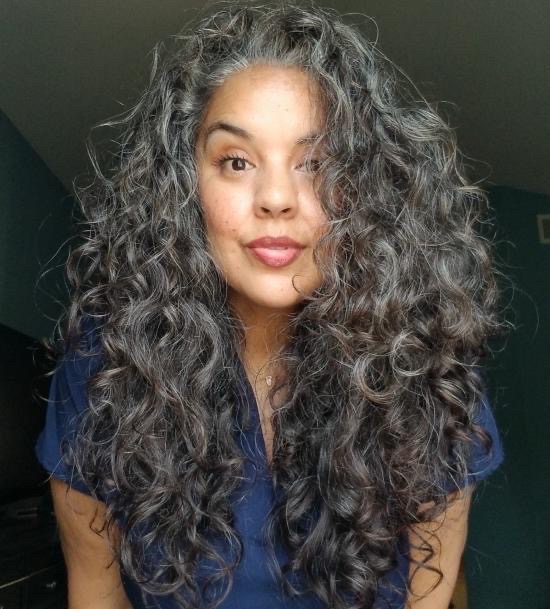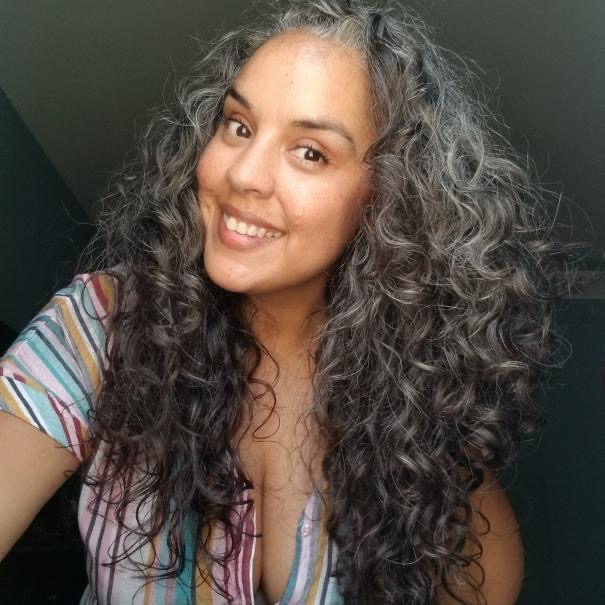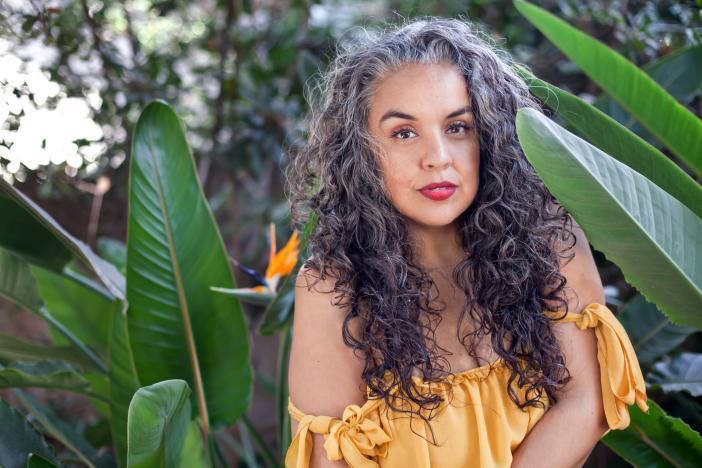Last Updated on November 18, 2020 by Kristen

Georgina of @curlysilverfox
When, Georgina, AKA Curlysilverfox, decided to stop dying her hair, the whites were showing up practically before rinsing the dye through her naturally curly hair. She had spent more hours straightening those curls than she cared to think about. And she started to wonder what the point of it all really was.
So she went cold turkey on both the dye and the straightener and it wasn’t easy, especially since she hadn’t yet discovered the “silver sisters” of social media. She was on her own, fending off unsolicited comments from family and friends (strangers were, surprisingly, more encouraging). She doubted her choices and cried in her closet more than once.
But, eventually, she owned the decision to go both silver and curly simultaneously, and she started loving what she saw in the mirror. Soon the positive changes were transforming her on the inside as well.
Her “grombre” journey got a booster charge when she joined Instagram, a move prompted by a stranger who asked if she had an account saying she’d love to look at pictures of her hair.
She discovered a community of women celebrating their gray-hair transitions and the eventual results in all their glory. She was even approached by a rep from daytime talkshow The Real, which was considering a segment on women who were embracing their grays but rejecting the old lady stigma.
“That was the first time it dawned on me that it was a bigger thing than my own little space,” Georgina said. “It gave me that little pivot that there are so many women who no longer want to be inside a box or look a certain way, or be like a certain mold.
And now she’s in the business of helping other women do the same both through her Instagram account and her recently-launched coaching business. Read more below to hear all about her gray-hair transition, her favorite products, and the surprisingly major impact the gray transition has had on her life.
Can you tell us where you live and a little bit about yourself?
“I live in Southern California in wine country in Temecula. I’m a women’s rebel coach. I went back to school in my 40s and decided that I needed to help women like myself reawaken and be unapologetic about who they are and who they want to become.”
Did you go back to school for coaching?
“I did. I was in a completely different field. I went to college to be social worker. I had my son right out of high school—I was a very young mom at age 18 when I was in college and something had to give. I was working full time, in school full time and raising a family. So my priority was taking care of him and my family, so I didn’t finish school and I started working full time in insurance. I did insurance for the majority of the first half of my life. And I always knew that there was something more for me.
I started to feel that pull that I think a lot of women do, that there’s something more and you don’t know what it is or what it looks like. My boys got older and they didn’t need a mom as much anymore I had gotten laid off and there was this period in my life where I really able to self-discover and I gave myself permission to do that, which I had never done before because it had always felt selfish to make myself a priority. A lot of women feel that way, that we’re somehow taking away from others if we make ourselves a priority. And I went through this space where I needed to become the person that I was supposed to.
So I did a lot of work on self and I decided to go back to school and also to go gray.
My sister said, ‘Oh, are you having a midlife crisis?’ So I wrote about and I asked myself, am I? But I didn’t feel like I was in crisis. I don’t feel like I was at a breaking point. I reframed it for myself that I was having a midlife ‘awakening.’ Because it didn’t feel like a crisis, it felt like I was finally allowing myself to become the woman I was meant to be. I wasn’t in crisis, I was just awakening.”
When did you first start going gray and, and, did you color it initially?
“I come from a long very white and salt and pepper lineage. My grandmother was all white, I mean snow white, and she had a beautiful olive complexion, so it looked beautiful on her, but she was my grandma. That’s acceptable, right?
My mother has salt and pepper hair, so I knew it was going to happen. I was in my early twenties when I started noticing them enough that I needed to cover them. Right after I had my son, all kinds of stuff happened. My body was changing, and I was like, nope, nope, nope, not going to happen. So I started coloring in my twenties, and that’s also when I started to straighten my hair, because I didn’t know how to take care of my hair and my curls. I didn’t know what was going on. It was a big, hot mess during that time.
I was touching up my hair every other week, because I had a crown of white. I would put the dye down and then pick it back up again. I had just had enough, so I had a really hard conversation with myself. Like, why are you doing that and who is that for? I remember having that conversation, like, why? What is the purpose? What is so wrong with who you are?

That was just where I was with everything in my life. I probably did it the hardest way: I decided to go curly, I decided to embrace my grays, and I decided to go back to school. The whole thing. So I had this crazy year of amazing growth, but at the same time, I would sit down in the closet crying because I thought it looked so ugly because I had a skunk line. Everybody tells you it’s like this beautiful thing and yes, it is, but you go through a lot of ugly self-talk because you’ve been covering up for such a long time.
Being that vulnerable and being that visible is scary. And you go through a lot of growth through that—I did anyway, that might not be everybody. I know some women who are just like, ‘I love it!’ And that’s amazing, but that was not me. I was crying.”
What made you keep going even though it was so difficult?
“I think I really kind of got to the point where I had heard so many negative things like, you’re too young, it’s gonna make you look old, are you sure you want to do that? All of those things that were meant to kind of get me down really had the opposite effect. You don’t get to determine how I feel about it. Who cares what you think. I’m a bit of a a rebel—I’m going to do what I want anyway.
And then the more I did it, the more I became self aware and started choosing self acceptance and self worth. I realized hair color doesn’t mean age. I had gray hair in my twenties and I wasn’t old. All the deprecating things that was say to ourselves aren’t true once we start accepting ourselves in all of our glory. So I think every time I chose to accept, it just pushed me to keep going because it felt good.”
It sounds like you did get a lot of comments from friends and family, and maybe even strangers. How did you respond to those comments?
“It’s interesting because I’d get a lot of negative comments from people I knew, and strangers were completely the opposite. I think what’s a little bit different for me is that I have curly hair. So when I was going through my process, I wasn’t part of any Facebook groups and I didn’t have Instagram and I was doing it alone. I didn’t have anybody. I’m Latina and I have curly hair and even now when I look on Instagram, there are not a lot of women who look like me. ”
It’s true it does seem like a white white hair movement.
“Yes I think that’s why I stand out. It’s not the norm in my Latina culture. I have family who are still like, nope, nope, nope, that’s never gonna happen, that’s for our grandmas. We’re not ready to do that. So the reaction has been positive because nobody looked like me who was doing it.”
That makes sense. And sometimes family is more comfortable telling you what they really think.
“Oh yeah, family has no filter. They have no problem being in your business. Absolutely.
And then there will be that friend who lives in Belfast and you guys are like best girlfriends even though you’ve never met in person. They love and support you from 6,000 miles away. The Internet’s amazing. It can also be kind of mean and cruel, and there’s an underbelly.

Georgina of @curlysilverfox
What made you get started on Instagram?
“Literally some lady asked me, ‘Do you have an Instagram account because I’d really like to look at pictures of your hair.’ And I’m like, really my hair? That’s weird. So I started the Instagram account in March of last year and I had been going gray for about a year at that point. I didn’t know about the whole silver sister community and everything that’s out there. I never in a million years thought anybody would care enough to be like hey, what you try my product? Really? Why?
I mean, I love it. I love helping other women. If I can help inspire them or answer a question or make them feel a little less alone in it. And I’m all for it because I wish I would have had that.”
As you’ve gone through this process, how has going gray changed how you feel about yourself?
“Honestly, there are a couple of things that happened. Number one I’m probably the most confident I’ve ever been. But at the same time I’ve gained 20 pounds in the last year. So for myself, going gray and owning that and my curls and my life and, you know, just doing the things that truly bring me joy has completely shifted the way that I perceive myself and it has less to do with the way that I look.”
Do you find that people respond to you any differently now that you’re here is white? Do you feel like maybe professionally or socially do people perceive you as an older person or, are they, for example, more delicate with you because they think you’re like older?
“That’s interesting because my son and I were having this conversation yesterday. He’s 24, and because I had him when I was so young, there were a lot of times when he would hate it because people would say oh, is that your sister? One time someone said are you waiting for your wife? And I walked in and he’s just like, are you kidding me that’s my mom.
He’a like a big tall guy and I’m like 5’ 6”. And I’m 42 so I looked pretty young. But now I don’t know if I do now or not. I think people stare at me because I’m kind of a walking oxymoron. People look at my face and think oh she looks young but then I have all this gray hair and they’re just confused.
And more often than not, men stop me more than women and tell me how much they love my hair. I was at the grocery store with my husband and this man stopped me and said I love your hair, don’t ever dye it, don’t ever change it. It’s beautiful, I wish more women would go natural.”
As far as men are concerned, I’ve noticed that a lot of these women’s profiles say they’re happily married and men, do not DM me. It seems like they’re having to fend off men who are…
“Trolls. Yeah, it’s rough. It’s the weirdest thing. I’m literally posting pictures of my hair, and the DMs are crazy. I had somebody email me because I wouldn’t message them back so he hit me up on email with pictures of himself.
In the last year I’ve probably deleted close to 3000 men. They are not my people. Only 10% of the people who actually follow you see your stuff, and if there are like 3000 of them who are men and bots or whatever… you are not who I want to engage with or see. Go away. I’m not in it for the follows. I mean it’s great. I love it. But I didn’t create the account for that.”
Have you become close either online or in person with any other women in this community?
“Yes there are a couple of women, we give each other tips and stuff. The people who follow me are a little bit of a mix of a lot of curly hair girls because now they know that if they go gray, it’s manageable. They’ll be able to do it. And then, there are a lot of Latin women who also have started following me.”
Has the consistency of your hair changed since you stopped dying it?
“Yes. So there are a couple things that have happened. I stopped using any products that contain harsh chemicals because they dry out your hair. And then a lot of women end up buying more products so they can make their hair softer or shiny or they can do all of their stuff.
When I started switching over to natural products, that automatically helped my hair heal because I had been coloring and straightening my hair for such a long time that I had caused a lot of damage.
So when my new hair growth started coming in, it was a lot healthier because it was no longer colored, but also what I had noticed is I have some very thick and wiry coarse hairs that came through. But having curly hair has made the transition easier for me because of how it blends together. You don’t have a straight demarcation line. Once it gets to a certain point, it all kind of just mixes in together. I have like a big lion’s mane. But changing to all-natural products has, has made my hair the healthiest it’s ever been. Even if it’s coarse it’s been manageable and it’s still soft.”
Do you have any favorite products?
“My biggest recommendation for everybody, it doesn’t matter what kind of hair you have but if you’ve color treated your hair, if you have hard water where you live, pollution, etc., deep condition is so important. I recommend that to everybody because it makes such a huge difference.
There are a couple of different deep conditioners that I really like that are all natural. One of them is a small Black female business owner and her brand is Woke Hair. She has three or four different deep conditioners. Some are for hair growth, some are for moisture, and I think she has a protein one.
I’ve also been working with Kerotin. They asked me to try their products, but they contained chemicals so I had declined initially, but they have a new line with avocado and aloe. It’s all natural and cruelty-free. I just deep conditioned with the mask the other day and I love it.
So my last question is, and you kind of covered it a little bit, but, what advice would you give someone who is considering letting their whites come through?
“Number one, don’t compare yourself to anybody else. I think that’s the biggest thing. It’s common to feel like I want my hair to look like hers, or I hope it looks like hers. There’s already a comparison even before we even begin. And it’s amazing to be inspired by somebody, but once you start putting yourself in comparison mode and it doesn’t grow out the way you want, you’re already putting yourself in a negative state of mind. That’s not fair to you. The thing is, none of us knows what it’s going to look like. I thought mine was going to be more white. Some just have this beautiful silver streak and that’s all they have. Some are salt and pepper. We’re all so different. So don’t compare yourself.”
Number two, patience is key. Patience patience, patience. That was not my strong suit. It took time for me. Because once I decided, and it got to a certain length, I’m like, okay, grow faster! It’s so weird because before I was like, no gray, go away. And now I’m just like, yes, give me more, give me more. You get to a point where you want the thing that you didn’t.
And the third thing I would say is: I’ve never seen a woman transition where it wasn’t stunningly beautiful, and where mother nature didn’t know what she was doing. Every single person that I’ve ever seen, their transition is perfect. Their skin tone or their face or their shape—it is what it’s meant to be. Trust the process.”
